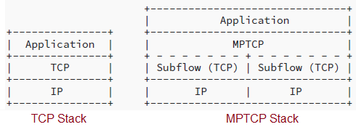Difference between HTTP over TCP and QUIC:Pros and Cons
Advertisement
Introduction : HTTP over TCP has powered internet for decades due to its reliable ordered delivery. The limitations of TCP such as inherent latency and head of line blocking have been more pronounced in mobile or streaming scenarios. QUIC utilizes UDP and integrates TLS 1.3. QUIC enables multiplexed and low latency connections which offers compelling alternative to TCP which improves page load times, reduces connection overhead for web browsing. QUIC addresses many of the bottlenecks of the TCP based stack. Let us learn these protocols and compare both with respect to various parameters.
TCP
HTTP/2 runs on top of TCP and brought major improvements such as multiplexing multiple requests over single connection, header compression and better utilization of TCP stream compared with HTTP/1.x. However, because it still relies on TCP’s ordered stream delivery, any packet loss or delay causes head of line blocking for all HTTP/2 streams on that connection. Each connection setup still incurs the usual TCP handshake plus TLS negotiation which increases setup time.

The figure-1 depicts HTTP over TCP and QUIC protocol stack layers.
QUIC
By contrast, HTTP/3 uses QUIC (built over UDP) as its transport, integrating TLS and allowing independently scheduled streams so that packet loss in one stream doesn’t stall the others. QUIC reduces round trip handshake latency, supports connection migration when the device’s network changes and avoids the TCP layer head of line bottleneck. These features make it beneficial in mobile, lossy or high latency networks.

The figure-2 depicts initial synchronization phase (i.e. handshake) between client and server for TCP with TLS as well as QUIC.

The figure-3 depicts single stream of data in one connection for TCP and multiple streams in single connection for QUIC.
Advantages of QUIC
Following are some of the benefits of QUIC protocol.
- This protocol merges transport and TLS handshakes which reduced required round trip times to greater extent. In many cases, it enables 0-RTT resumption. Hence it offers faster connection setup.
- QUIC mandates encryption by providing built-in TLS 1.3 protocol. Hence it increases privacy and security compared to setups where encryption is optional feature.
- QUIC allows multiple streams in single connection. Hence loss on one stream does not block progress on other streams.
- It offers smooth connection migration as it supports surviving IP address or network interface changes without tearning down and re-establishing entire connection.
- Due to its improved loss recovery, stream independence and reduced handshake latency, it often performs better in adverse network conditions.
Disadvantages of QUIC
Following are some of the drawbacks of QUIC protocol.
- As QUIC is newer to TCP, some networks, firewalls, middleboxes or enterprise proxies may not fully support it. Hence QUIC packet flow may be blocked which forces fallback to older protocols.
- QUIC combines many functionalities in user space, which can add CPU overhead and complexity, especially for smaller devices or servers.
- It offers reduced visibility for monitoring and debugging by network operators as it encrypts more of the packet headers and metadata.
- As per some research, in cases where bandwidth is higher and environment is less lossy, QUIC may underperform compared to optimized TCP stacks due to its user space overhead or UDP limitations.
- QUIC is new protocol and its ecosystem is still maturing. This adds uncertainty for its adoption.
Multipath QUIC (MP-QUIC)
-
Multipath QUIC builds on the foundation of QUIC by enabling a single connection to use multiple network paths simultaneously. For example sending packets over Wi-Fi and cellular or over different IP addresses in parallel which improves throughput, resilience and fail over performance. Unlike standard QUIC, which typically uses one path per connection, MP-QUIC can schedule data over several interfaces at once.
-
Standard Status : It is currently at draft stage and being standardized towards RFC specification. MP-QUIC is currently specified in an IETF Internet Draft titled “Multipath Extension for QUIC” (draft-ietf-quic-multipath-16, August 2025).
Key differences
| Parameter | HTTP Over TCP | HTTP over QUIC (HTTP/3) |
|---|---|---|
| Underlying transport | TCP (Stream, ordered) | UDP |
| Connection setup latency | TCP handshake + TLS handshake (~2-3 RTTs) | QUIC integrates TLS handshake, supports 0-RTT resumption |
| Head of line blocking at transport layer | Yes, TCP treats the connection as a single ordered stream | No, QUIC handles streams independently. |
| Encryption | Usually TLS is layered on top of TCP; it is optional in older HTTP versions | Built-in TLS 1.3 as integral part of QUIC; encryption is mandatory |
| Connection migration & IP Change Support | Difficult as TCP binding to IP address/Port means network change usually breaks connection. | Designed for migration. QUIC uses connection IDs and hence network interface changes do not drop session. |
| Deployment maturity & compatibility | Very mature; supported everywhere | Newer but rapidly adopted ; some middlebox, firewall, or UDP restrictions may still apply |
Conclusion: QUIC addresses some of the limitations of TCP by combining transport and security handshakes, multiplexing independent streams without head of line blocking and allowing seamless migration across network changes. Websites that embrace HTTP over QUIC will have faster load times, smooth streaming performance and improved mobile responsiveness. The http over QUIC offers strong user experience but will take sometime for its complete adoption in the web domain.
Advertisement
 RF
RF








